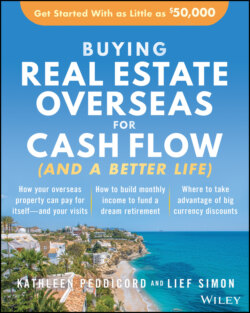Читать книгу Buying Real Estate Overseas For Cash Flow (And A Better Life) - Kathleen Peddicord - Страница 42
What Frank Lloyd Wright Taught Us About Other People's Money
ОглавлениеLief's first real estate purchase was in Chicago. He was renting in a three-flat when the owner sent a notice to all the tenants informing them he was listing the property for sale. It was a Frank Lloyd Wright building. Lief's apartment was big, the layout comfortable. He didn't want to give it up, so, rather than considering where he might move, Lief began figuring out a way to buy the building where he was living. Unfortunately, the people living on the top floor had the same idea and approached the owner with a plan to convert the building into condos so they could buy their apartment. That inflated the price in the seller's mind.
Undaunted, Lief put together a spreadsheet to see if he could make the numbers work for an outright purchase. He'd continue living in his apartment, paying himself rent, and rent out the other two. He calculated that he could charge more for those other units, as the current rents were below market.
Banks were offering special programs for first-time buyers. Lief knew he could get a loan. The question was whether the cash-flow math worked. Would the three apartments generate enough income to support the mortgage?
Using leverage to buy a rental property is a common strategy in the United States. The theory is that the rent pays back the bank, month by month, and covers your other expenses, hopefully with some cash flow left over. Meanwhile, equity builds up as the mortgage gets paid down … while, in theory, the property's value appreciates. How to buy with other people's money (OPM) is the first strategy you learn at any real estate investment seminar.
Lief obtained a mortgage with a loan-to-value ratio (LTV) of 98%. However, it wasn't for the building where he was living. His neighbor's condo plan botched that deal. But the seed had been planted and the spreadsheet created. Lief's math showed him what to do next.
He found a real estate agent and explained his parameters. Today we make buy decisions based on projected rental yields, gross and net. For this first purchase Lief didn't think beyond paying the mortgage.
He spent four months considering dozens of properties and entering the details for each into his spreadsheet. Two-flat buildings never came close to break-even cash flow, though Lief figures he probably could have made the math work for many of the buildings he looked at by increasing his own rent, but he didn't want to do that. Again, his stubbornness paid off (as he likes to point out for Kathleen's benefit). Lief kept active in the market, looking daily at new listings, until he found a property that fit his requirements. It was a building that had come back onto the market after the woman who had signed a purchase contract for it failed to qualify for financing. She was a hairdresser (but not Irish).
The price was good. The location was within the zone Lief had targeted. Most important, the numbers worked. Lief could keep paying himself the same rent and would be able to cover the mortgage even without increasing the rent for the other two apartments.
We met two-and-a-half years later, when, coincidentally, we both were making plans to move to Ireland. We were engaged two-and-a-half months after we met and married two months after that. Then we moved together—Lief from Chicago, Kathleen from Baltimore—to Waterford. The timing was ideal for selling Lief's three-flat. The Chicago market was frothy. He set the price above the going market rate, and the building still sold quickly. He walked away with 80% more than he'd paid less than three years earlier. The leveraged return on Lief's 2% down payment was 3,000%. He had turned $5,000 into $150,000 after closing costs and commissions. And he'd had positive cash flow from rental income every month he had owned the building.
It was an as-good-as-it-gets property investment experience, first because Lief made the buy decision based on cash flow math and second because he was able to leverage the purchase.
Buying with OPM can—as any property investor will tell you—mean an upside, but it comes with risk. It doesn't matter what your property is worth if the cash flow it generates doesn't cover the mortgage. We've known too many U.S. real estate investors who have lost too many properties when market changes collapsed their highly leveraged portfolios.
Even though we've benefited from it, we don't preach the OPM mantra. Twenty-five years of experience across 24 markets worldwide, including the United States, have taught us to respect the fundamentals. We don't buy unless the projected net rental yields translate into cash flow enough to support the investment.
